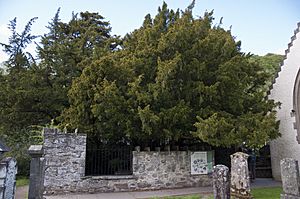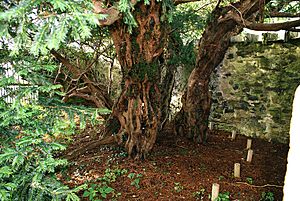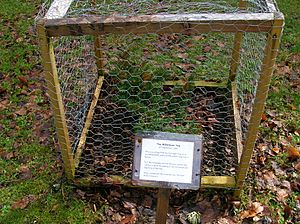Fortingall Yew facts for kids
The Fortingall Yew is a very old tree found in the village of Fortingall in Perthshire, Scotland. It's a type of tree called a European yew (Taxus baccata). This amazing tree grows in a churchyard and is famous for being one of the oldest trees in Britain. Experts believe it is between 2,000 and 3,000 years old.
Contents
How Old is the Fortingall Yew?
Experts today think the Fortingall Yew is between 2,000 and 3,000 years old. Some people have even guessed it could be as old as 5,000 to 9,000 years! This makes it one of the oldest trees known in Europe.
For comparison, the root system of a tree called Old Tjikko in Sweden is at least 9,500 years old. The Fortingall Yew is thought to be the oldest tree in all of Britain.
What Does the Fortingall Yew Look Like?
When people first wrote about the tree in 1769, its trunk was huge. It was about 52 feet (16 meters) around! Over time, the middle part of the trunk, called the heartwood, decayed. This natural process made the trunk split into several smaller stems. Now, it looks like a few smaller trees growing together.
Even though its center has decayed, the tree is still healthy. It could live for many more centuries. In the past, people even took pieces of the trunk to make drinking cups. To protect it, a low wall was built around the tree in 1785. You can still easily see the tree today.
Protecting the Fortingall Yew
Scientists have taken small pieces, called clippings, from the Fortingall Yew. These clippings are grown at the Royal Botanic Gardens in Edinburgh. They are part of a special project to create a long hedge. This "Yew Conservation Hedge Project" helps save the DNA of ancient yew trees in the UK. Yew trees around the world are at risk from being cut down or getting sick.
In 2019, some people worried that too many tourists climbing on or around the tree could harm it. They want to make sure the tree stays safe for a long time.
History of the Fortingall Area
The area around Fortingall has many ancient sites from long ago. For example, there's a Bronze Age burial mound called Càrn na Marbh. Some clues suggest that Fortingall might have been an important religious place in the Iron Age. The Fortingall Yew tree might have been a special part of this ancient site.
Later, the area became a Christian site during the Early Middle Ages. The yew tree was already very old and large by then. This might be because it was already seen as a sacred place. An old story from 1804 says that village boys once damaged the tree. They lit their Bealltuinn (a traditional fire) at its roots.
A famous writer named Rev. James MacGregor was a minister in the church during the 1500s. He wrote the Book of the Dean of Lismore.
How the Fortingall Yew Changed Sex
The Fortingall Yew tree is usually male. However, in 2015, scientists from the Royal Botanic Garden, Edinburgh made an interesting discovery. They found that one small branch on the tree had changed sex! This branch started to grow a few berries.
This kind of change can sometimes happen in certain plants, including yews. It might be caused by things like environmental stress. The seeds from these berries have been saved for study. They will help scientists keep the genetic variety of yew trees strong.
The Legend of Pontius Pilate
There is a local legend about the Fortingall Yew. The story says that Pontius Pilate was born in the shade of this tree. It also says he played there when he was a child. However, Dr. Paul S Philippou, a history expert, believes this legend is not true. He thinks it's an old myth that has been made more exciting over time.
See also
 In Spanish: Tejo de Fortingall para niños
In Spanish: Tejo de Fortingall para niños




